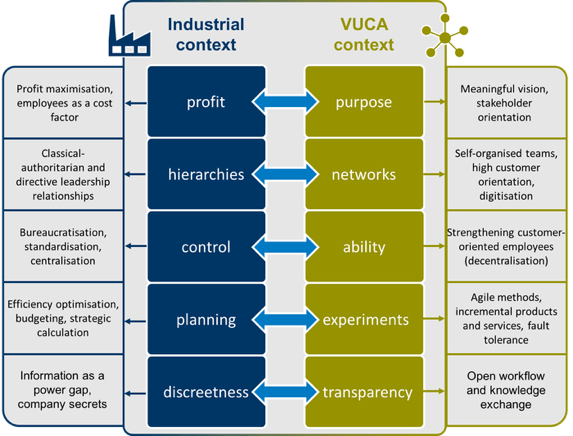Agile transformation (part 3) - three relevant premises
Which basic conditions are necessary to successfully implement an agile transformation in a company?
On the one hand, companies are challenged to be innovative and to react faster and more flexibly to market requirements - and this with increasing complexity. On the other hand, they must not neglect their bread and butter business, including the established processes and procedures. It is precisely this dichotomy that increasingly drives companies into agile projects, says Marc Stoffel: "They hope that their entire organization can become more flexible so that they can react accordingly to changes. Today, employees already spend an average of 35 percent of their working time on projects. However, this does not yet say anything about the success of this form of organization. According to the study, almost every sixth project fails.
Companies in the VUCA world have to meet the demands and challenges of innovation, speed and flexibility in order to be able to react to market demands. On the other hand, normal day-to-day business with regard to established processes and procedures must not be neglected.
The convulsive attempt to inhale an agile "mindset" with pressure could lead to agile bronchitis instead of agile transformation. What is important so that in established corporate structures, in established processes and in a culture of cooperation and leadership shaped over the years, a transformation can begin to enable the company for current and future market requirements?
I will discuss three basic prerequisites in more detail below.
How do organizational design and the employees' understanding of work fit together?
Agile organizations can be economically successful if they create value as efficiently as possible. On the other hand, it is crucial to keep an eye on the performance and potential development of each employee so that the employees are not overtaxed and develop a defensive attitude when they have to change from a "command and control context" into a participative context.
In this case, leadership models that understand leadership as a service are crucial. With such a management attitude, managers focus on the personal development of all employees. Therefore, check whether your current organizational design enables or promotes indications of the design of leadership of this kind.
Dual operating systems or "adaptive structures" allow a variety of organizational forms within a company. On the one hand, they create the highest possible efficiency ("exploitation") through their standardization, but on the other hand, through agile networks and cross-functional teams they offer sufficient opportunities to release individual potential and thus promote creativity and innovation (exploration). They thus combine efficiency and agility and at the same time offer a framework for the development of individual potential through balanced leadership.
Fig.: Comparison industrial vs. VUCA context (see website)
Is the cooperation in daily cooperation more characterized by competition or cooperation?
If the corporate culture has so far been distinguished by acting primarily according to KPI's and the colleague was more of a competitor than a colleague, then it is likely that departments and teams will be isolated as a result.
Silodenken and perhaps even mutual accusations quickly find their place in such an environment. Nobody sees the big picture, each department only looks after itself so that it performs well in the eyes of the management.
A healthy culture is based on shared values such as cooperation and personal responsibility. In such an atmosphere, the development of new services can be successful directly from decentralized, interdisciplinary teams.
The imparting and living of values such as openness, commitment, respect and integrity as well as the focus on the common are essential prerequisites for a successful agile transformation.
Are you as a manager convinced of the correctness and importance of an agile transformation?
Depending on your influence, this is probably the most decisive prerequisite for an agile transformation in an organization.
Is the executive absolutely convinced internally that it makes sense and is important to start a transformation in your organization that leads to the fact that instead of "Command-and-Control" in the future they not only allow but even promote empowerment, trust and personal responsibility?
Certainly there will be areas of the company where you may ask yourself whether it makes sense at all to anchor an "agile mindset". On the other hand, there will probably be enough areas where successful agile transformation is the key to staying successful in the market and more than getting along in the VUCA world.
It is difficult to rethink and to question perhaps years of successful leadership. But managers in particular are characterised by an open attitude and a willingness to learn. Here, managers can have a decisive influence on the success of their organisation.
Conclusion
In order to initiate an agile transformation, three prerequisites, among others, are indispensable:
1) The fit between organizational design and work understanding.
2) Cooperation as a leitmotif for cooperation.
3) The decision makers are absolutely convinced of the necessity and importance of an agile transformation.
If you would like to learn more about "Agile Transformation", organizational design or coaching, please feel free to inform yourself about our services in this area or simply contact us.
Outlook
In the next article, we continue the series with tips for creating a realistic, agile roadmap.
Further blog posts from the series "Agile transformation":
Agile transformation (part 1) - classic vs. agil
Agile transformation (part 2) - analysis of the status quo
Agile transformation (part 4) - designing a roadmap
Agile transformation (part 5) - setting up a pilot project
Agile transformation (part 6) - methods and instruments
Agile transformation (part 7) - step on it!
Agile transformation (part 8) - questions and answers
Literature:
Häusling, A., Römer, E. & Zeppenfeld, N. (2017). Agility practice book. Tools for personnel and organizational development. Freiburg: Haufe.
Kallenbach, I. (2016). Leadership in a Healthy Organization. Exceptional performance through potential development. Stuttgart: Schäffer-Poeschel.

